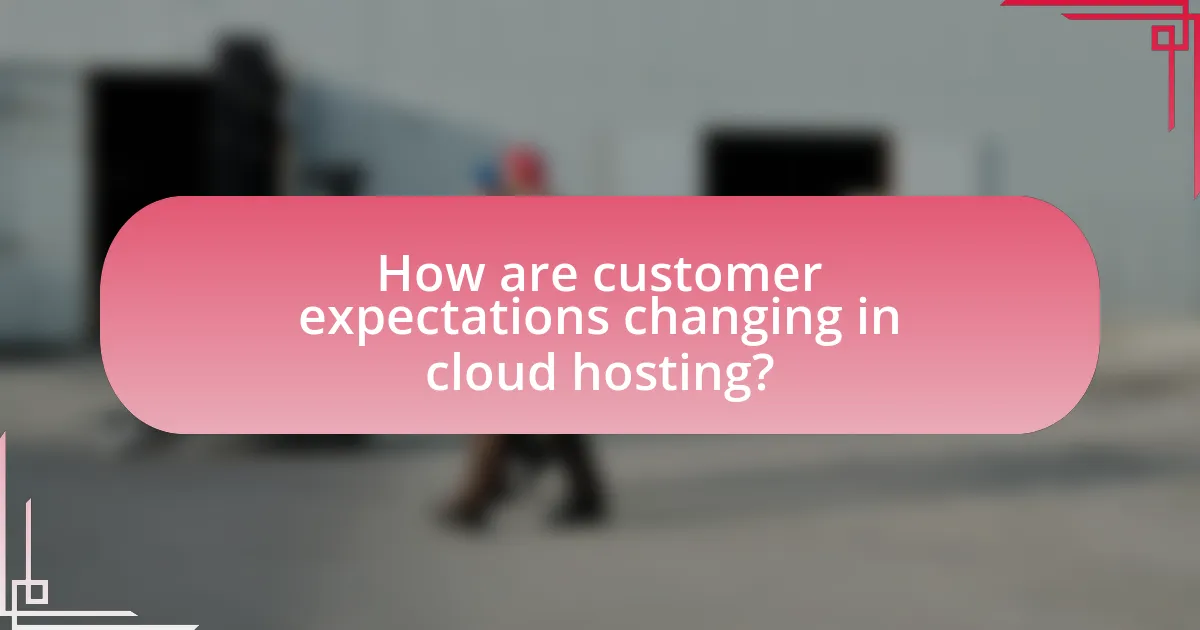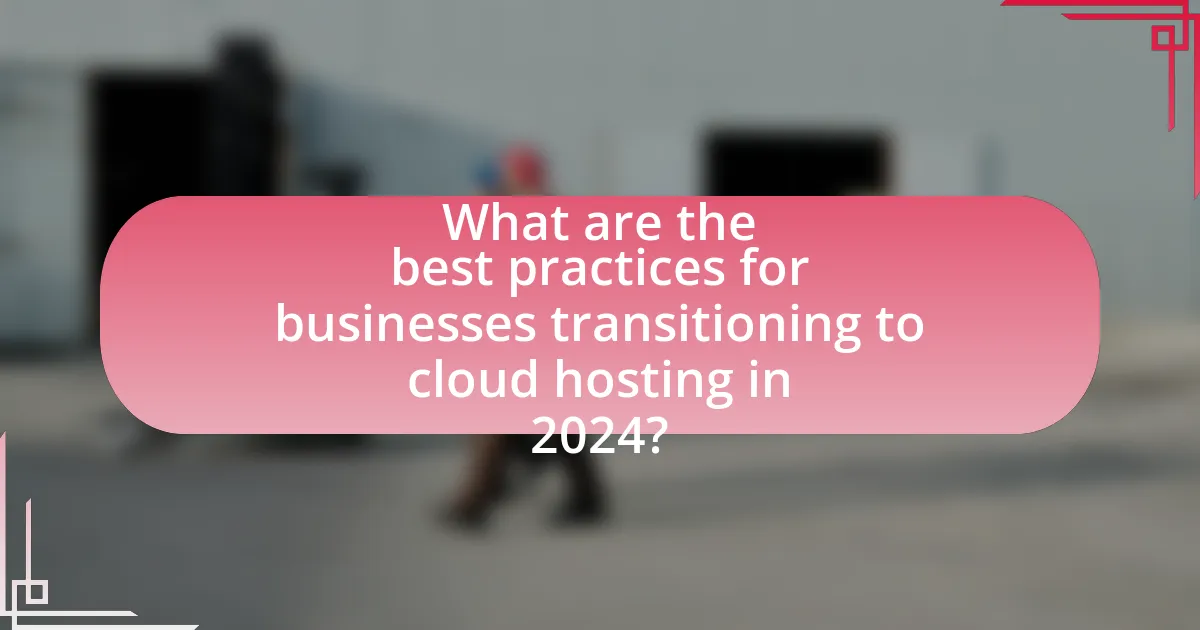The article focuses on the future of cloud hosting, highlighting key trends expected to shape the industry in 2024. It discusses the increasing adoption of multi-cloud strategies, enhanced security measures, and the rise of serverless computing, driven by the demand for scalability, cost efficiency, and improved data protection. The article also examines the evolving customer expectations for performance and flexibility, the impact of technological advancements like artificial intelligence and edge computing, and the emerging security challenges that organizations face. Additionally, it outlines best practices for businesses transitioning to cloud hosting, emphasizing the importance of strategic planning, compliance, and effective vendor management.

What are the key trends shaping the future of cloud hosting in 2024?
The key trends shaping the future of cloud hosting in 2024 include increased adoption of multi-cloud strategies, enhanced security measures, and the rise of serverless computing. Multi-cloud strategies allow organizations to leverage multiple cloud services for improved flexibility and risk management, with 81% of enterprises reportedly using a multi-cloud approach according to a 2023 report by Flexera. Enhanced security measures are driven by the growing concern over data breaches, leading to investments in advanced encryption and compliance solutions. Additionally, serverless computing is gaining traction as it enables developers to focus on code without managing infrastructure, with a projected market growth rate of 22% annually through 2026, as reported by MarketsandMarkets.
How is the demand for cloud hosting evolving in 2024?
The demand for cloud hosting is expected to grow significantly in 2024, driven by increasing adoption of digital transformation initiatives across various industries. According to a report by Gartner, the global public cloud services market is projected to reach $600 billion in 2024, reflecting a compound annual growth rate of 21% from 2022. This growth is fueled by businesses seeking scalable, flexible, and cost-effective solutions to manage their IT infrastructure, particularly as remote work and online services continue to expand. Additionally, advancements in cloud technologies, such as artificial intelligence and machine learning integration, are further enhancing the appeal of cloud hosting solutions, leading to increased demand.
What factors are driving increased adoption of cloud hosting services?
Increased adoption of cloud hosting services is primarily driven by the need for scalability, cost efficiency, and enhanced security. Organizations are increasingly seeking flexible solutions that allow them to scale resources up or down based on demand, which cloud hosting provides effectively. According to a report by Gartner, 70% of organizations plan to increase their cloud spending in 2024, highlighting the trend towards cost-effective resource management. Additionally, advancements in security protocols and compliance measures have made cloud services more appealing, as businesses prioritize data protection and regulatory adherence. This combination of scalability, cost efficiency, and security is propelling the widespread adoption of cloud hosting services.
How are businesses adapting to changing cloud hosting needs?
Businesses are adapting to changing cloud hosting needs by implementing hybrid cloud solutions that combine public and private cloud resources. This approach allows organizations to maintain flexibility, optimize costs, and enhance security by keeping sensitive data on private servers while leveraging the scalability of public clouds for less critical workloads. According to a report by Gartner, by 2025, 85% of enterprises will adopt a cloud-first principle, indicating a significant shift towards cloud-centric strategies. Additionally, businesses are increasingly utilizing containerization and microservices architectures to improve application deployment and management, further aligning with evolving cloud capabilities.
What technological advancements are influencing cloud hosting?
Technological advancements influencing cloud hosting include artificial intelligence, edge computing, and serverless architecture. Artificial intelligence enhances cloud services by automating resource management and optimizing performance, as evidenced by AI-driven tools that predict workload demands and adjust resources accordingly. Edge computing reduces latency by processing data closer to the source, which is critical for applications requiring real-time data analysis, such as IoT devices. Serverless architecture allows developers to build and run applications without managing servers, leading to increased efficiency and cost savings, as it automatically scales resources based on demand. These advancements collectively shape the future landscape of cloud hosting, driving innovation and improving service delivery.
How is artificial intelligence impacting cloud hosting solutions?
Artificial intelligence is significantly enhancing cloud hosting solutions by optimizing resource management and improving security measures. AI algorithms analyze usage patterns to allocate resources dynamically, ensuring efficient performance and cost-effectiveness. For instance, according to a report by Gartner, AI-driven automation in cloud services can reduce operational costs by up to 30%. Additionally, AI enhances security by identifying and mitigating threats in real-time, with IBM reporting that AI can reduce the time to detect a data breach by 27%. These advancements demonstrate that AI is transforming cloud hosting into a more efficient and secure environment.
What role does edge computing play in the future of cloud hosting?
Edge computing significantly enhances cloud hosting by reducing latency and improving data processing efficiency. By processing data closer to the source, edge computing minimizes the distance data must travel, which is crucial for applications requiring real-time responses, such as IoT devices and autonomous systems. According to a report by Gartner, by 2025, 75% of enterprise-generated data will be processed outside the centralized data center, highlighting the shift towards decentralized computing models. This trend indicates that cloud hosting will increasingly integrate edge computing to meet the demands for speed and reliability in data handling.
What are the emerging security challenges in cloud hosting?
Emerging security challenges in cloud hosting include data breaches, misconfigured cloud settings, and inadequate access controls. Data breaches are increasingly common, with reports indicating that 60% of organizations experienced a cloud-related security incident in the past year, highlighting the vulnerability of sensitive information stored in the cloud. Misconfigured cloud settings, often due to human error, can expose data to unauthorized access; a study by the Cloud Security Alliance found that 70% of cloud security failures are attributed to misconfigurations. Inadequate access controls further exacerbate these issues, as organizations struggle to manage user permissions effectively, leading to potential insider threats and unauthorized data access.
How can businesses mitigate risks associated with cloud security?
Businesses can mitigate risks associated with cloud security by implementing a multi-layered security strategy that includes data encryption, access controls, and regular security audits. Data encryption protects sensitive information both at rest and in transit, making it unreadable to unauthorized users. Access controls ensure that only authorized personnel can access specific data and applications, reducing the risk of insider threats. Regular security audits help identify vulnerabilities and ensure compliance with industry standards, such as the General Data Protection Regulation (GDPR) and the Health Insurance Portability and Accountability Act (HIPAA). According to a report by McKinsey & Company, organizations that adopt a comprehensive cloud security framework can reduce the likelihood of data breaches by up to 70%.
What compliance regulations should cloud hosting providers be aware of?
Cloud hosting providers should be aware of several key compliance regulations, including the General Data Protection Regulation (GDPR), the Health Insurance Portability and Accountability Act (HIPAA), and the Federal Risk and Authorization Management Program (FedRAMP). GDPR mandates strict data protection and privacy for individuals within the European Union, requiring cloud providers to implement robust data handling practices. HIPAA sets standards for the protection of health information in the United States, necessitating that cloud services used by healthcare organizations comply with its security and privacy rules. FedRAMP provides a standardized approach to security assessment, authorization, and continuous monitoring for cloud products and services used by federal agencies, ensuring that cloud providers meet specific security requirements. These regulations are critical for maintaining legal compliance and protecting sensitive data in cloud environments.

How are customer expectations changing in cloud hosting?
Customer expectations in cloud hosting are increasingly focused on enhanced performance, security, and flexibility. As businesses migrate to cloud solutions, they demand faster response times and higher uptime guarantees, with many providers now offering Service Level Agreements (SLAs) that promise 99.99% uptime. Additionally, security has become a top priority, with customers expecting robust data protection measures, including end-to-end encryption and compliance with regulations such as GDPR. Flexibility is also critical, as organizations seek scalable solutions that can adapt to their changing needs, leading to a rise in demand for customizable cloud services. According to a 2023 report by Gartner, 70% of organizations are prioritizing cloud security and performance in their purchasing decisions, highlighting the shift in customer expectations.
What features do customers prioritize in cloud hosting services?
Customers prioritize scalability, reliability, security, and performance in cloud hosting services. Scalability allows businesses to adjust resources based on demand, ensuring they only pay for what they use. Reliability is crucial, as customers seek uptime guarantees, often looking for providers that offer at least 99.9% uptime. Security features, including data encryption and compliance with regulations like GDPR, are essential to protect sensitive information. Performance, measured by speed and latency, directly impacts user experience, making it a top concern for customers. According to a 2023 survey by Gartner, 70% of organizations consider scalability and reliability as the most critical factors when selecting a cloud hosting provider.
How important is scalability for businesses using cloud hosting?
Scalability is crucial for businesses using cloud hosting as it allows them to adjust resources based on demand efficiently. This flexibility enables companies to accommodate growth, manage peak loads, and optimize costs by only paying for the resources they use. According to a report by Gartner, 70% of organizations cite scalability as a primary reason for adopting cloud solutions, highlighting its significance in maintaining competitive advantage and operational efficiency.
What role does customer support play in cloud hosting satisfaction?
Customer support is crucial for cloud hosting satisfaction as it directly impacts user experience and service reliability. Effective customer support ensures timely resolution of technical issues, which is essential for maintaining uptime and performance in cloud environments. According to a study by Zendesk, 82% of customers have stopped doing business with a company due to poor customer service, highlighting the importance of responsive support in retaining clients. Additionally, positive interactions with customer support can enhance user trust and loyalty, further contributing to overall satisfaction in cloud hosting services.
How is pricing evolving in the cloud hosting market?
Pricing in the cloud hosting market is evolving towards more competitive and flexible models, driven by increased competition and customer demand for cost-effective solutions. Major providers like Amazon Web Services, Microsoft Azure, and Google Cloud have introduced pay-as-you-go pricing, reserved instances, and spot pricing to cater to diverse customer needs. According to a report by Synergy Research Group, the cloud infrastructure market grew by 35% year-over-year in 2022, indicating a strong demand that encourages providers to innovate pricing strategies. Additionally, the rise of multi-cloud strategies has led to providers offering more tailored pricing options to attract businesses looking for flexibility and cost savings.
What pricing models are becoming popular among cloud hosting providers?
Usage-based pricing models are becoming popular among cloud hosting providers. This model allows customers to pay only for the resources they consume, which aligns costs with actual usage, making it more cost-effective for businesses. According to a report by Gartner, 70% of organizations are expected to adopt usage-based pricing for cloud services by 2024, reflecting a significant shift from traditional flat-rate pricing models. Additionally, tiered pricing structures are gaining traction, enabling customers to select from various service levels based on their needs, further enhancing flexibility and scalability in cloud hosting solutions.
How can businesses optimize their cloud hosting costs?
Businesses can optimize their cloud hosting costs by implementing a combination of resource management strategies, such as rightsizing instances, utilizing reserved instances, and leveraging auto-scaling features. Rightsizing involves analyzing current usage patterns to ensure that the allocated resources match the actual needs, which can reduce unnecessary expenses. Utilizing reserved instances allows businesses to commit to a specific usage level over a period, often resulting in significant discounts compared to on-demand pricing. Additionally, auto-scaling enables businesses to automatically adjust resources based on real-time demand, preventing over-provisioning and minimizing costs during low-traffic periods. According to a report by Gartner, organizations can save up to 30% on cloud costs by effectively managing their cloud resources and optimizing their usage.

What are the best practices for businesses transitioning to cloud hosting in 2024?
The best practices for businesses transitioning to cloud hosting in 2024 include conducting a thorough assessment of current IT infrastructure, selecting the right cloud service model (IaaS, PaaS, or SaaS), and ensuring data security and compliance. Businesses should evaluate their existing systems to identify which applications and data can be migrated to the cloud, facilitating a smoother transition. Choosing the appropriate cloud service model is crucial, as it impacts scalability, cost, and management. Additionally, implementing robust security measures, such as encryption and access controls, is essential to protect sensitive data and comply with regulations like GDPR or HIPAA. According to a 2023 report by Gartner, 85% of organizations that prioritize security during their cloud transition experience fewer data breaches, highlighting the importance of these practices.
How can organizations effectively plan their migration to cloud hosting?
Organizations can effectively plan their migration to cloud hosting by conducting a thorough assessment of their current IT infrastructure and defining clear objectives for the migration. This involves evaluating existing applications, data, and workloads to determine which are suitable for the cloud, as well as identifying potential cost savings and performance improvements. According to a report by Gartner, 70% of organizations that have migrated to the cloud have seen improved operational efficiency, highlighting the importance of strategic planning in achieving desired outcomes. Additionally, organizations should develop a detailed migration roadmap that includes timelines, resource allocation, and risk management strategies to ensure a smooth transition.
What steps should be taken to ensure a smooth transition?
To ensure a smooth transition to cloud hosting, organizations should follow a structured approach that includes thorough planning, stakeholder engagement, and robust testing. First, conducting a comprehensive assessment of current infrastructure and identifying specific needs will help tailor the transition strategy. Engaging stakeholders early in the process ensures alignment and addresses concerns, which is crucial for user adoption. Additionally, implementing a phased migration plan allows for gradual adjustments and minimizes disruptions. Testing the new cloud environment before full deployment is essential to identify potential issues and ensure compatibility with existing systems. These steps are supported by industry best practices, which emphasize the importance of preparation and stakeholder involvement in successful cloud transitions.
How can businesses assess their readiness for cloud hosting adoption?
Businesses can assess their readiness for cloud hosting adoption by evaluating their current IT infrastructure, workforce skills, and organizational goals. This assessment involves conducting a thorough analysis of existing hardware and software capabilities, identifying gaps in technical expertise among staff, and aligning cloud adoption with strategic business objectives. According to a report by Gartner, 70% of organizations that fail to adopt cloud solutions effectively cite inadequate skills and knowledge as a primary barrier, highlighting the importance of workforce readiness. Additionally, businesses should consider their data security requirements and compliance regulations, as these factors significantly influence cloud adoption success.
What common pitfalls should businesses avoid when adopting cloud hosting?
Businesses should avoid inadequate planning when adopting cloud hosting. Insufficient assessment of needs can lead to selecting inappropriate services, resulting in wasted resources and unmet expectations. Additionally, neglecting security measures can expose sensitive data to breaches; a report by IBM indicates that the average cost of a data breach is $4.24 million. Furthermore, failing to train staff on cloud technologies can hinder effective utilization, as a study by Gartner shows that 60% of cloud projects fail due to lack of user adoption. Lastly, overlooking compliance requirements can lead to legal issues, as regulations like GDPR impose strict data handling standards.
How can organizations ensure data integrity during the transition?
Organizations can ensure data integrity during the transition by implementing robust data validation processes and utilizing encryption techniques. Data validation processes, such as checksums and data profiling, help verify that data remains accurate and consistent throughout the transition. Encryption techniques protect data from unauthorized access, ensuring that sensitive information is secure during transfer. According to a study by the International Journal of Information Management, organizations that employ these methods experience a 30% reduction in data integrity issues during transitions.
What strategies can help in managing vendor relationships effectively?
Effective vendor relationship management can be achieved through clear communication, regular performance evaluations, and collaborative goal setting. Clear communication ensures that both parties understand expectations and requirements, reducing misunderstandings. Regular performance evaluations, such as quarterly reviews, help identify areas for improvement and reinforce accountability. Collaborative goal setting aligns the vendor’s objectives with the organization’s needs, fostering a partnership mentality. According to a study by the Institute for Supply Management, organizations that prioritize strong vendor relationships see a 20% increase in overall performance metrics, demonstrating the tangible benefits of these strategies.
What practical tips can enhance the cloud hosting experience in 2024?
To enhance the cloud hosting experience in 2024, users should prioritize optimizing resource allocation through automated scaling. Automated scaling allows cloud resources to adjust dynamically based on demand, ensuring efficient use of resources and cost savings. According to a report by Gartner, organizations that implement automated scaling can reduce operational costs by up to 30% while improving performance during peak usage times. Additionally, adopting multi-cloud strategies can enhance reliability and flexibility, as it allows businesses to leverage the strengths of different cloud providers. A study by Flexera indicates that 93% of enterprises have a multi-cloud strategy, which helps in avoiding vendor lock-in and optimizing service delivery.















